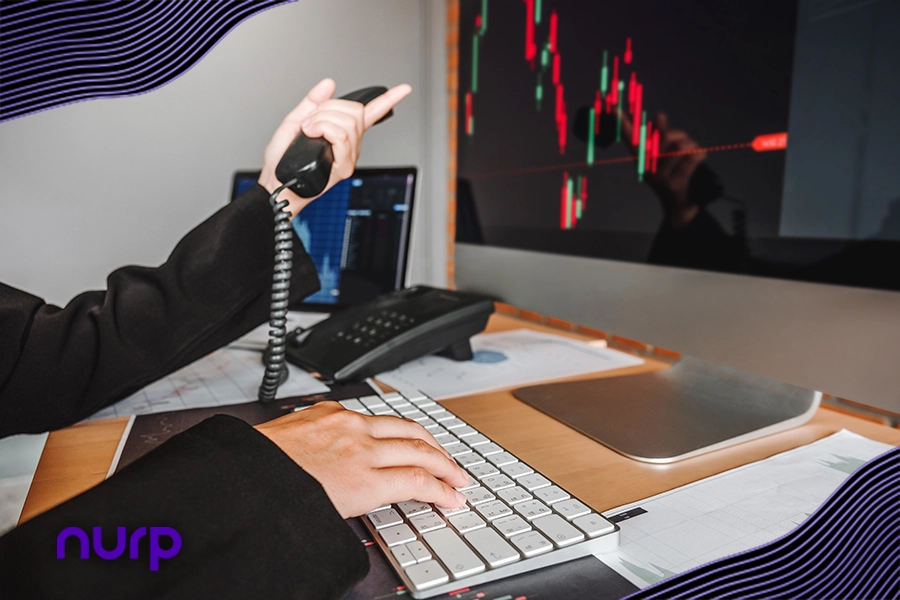Key Takeaways
Forex arbitrage allows traders to capitalize on price differences in currency pairs across various markets, offering the potential for profit without significant risk exposure.
Cutting-edge technology, including high-speed trading algorithms and automated systems, empowers traders to execute arbitrage strategies swiftly and accurately, enhancing efficiency and maximizing profitability.
Effective risk management strategies and compliance with regulatory requirements are critical for navigating the complexities of forex arbitrage, protecting capital, and ensuring long-term success in the dynamic forex market.
Introduction
The forex market is the largest and most liquid financial market in the world. Within this dynamic market, traders engage in buying and selling currencies with the aim of profiting from fluctuations in exchange rates.
Arbitrage is a powerful strategy that forex traders utilize to capitalize on price differences between currency pairs across different markets or exchanges. Essentially, forex arbitrage involves buying a currency at a lower price in one market and selling it at a higher price in another, profiting from the price differential. This practice has a major influence on trading as it allows traders to exploit market inefficiencies and generate profits with minimal risk exposure.
Arbitrage provides an avenue for generating returns with minimal market risk by enabling traders to profit from temporary price discrepancies between currency pairs. By leveraging arbitrage opportunities, traders have a chance to enhance their trading performance and achieve better outcomes.
This article dives into the world of forex arbitrage trading and explores the various types of arbitrage strategies. It also examines the factors driving arbitrage opportunities, and the role of technology in arbitrage trading. In addition, it explores risk management strategies for mitigating potential losses and navigating the regulatory landscape. By the end, readers will have gained insights into how forex arbitrage works, and how they can leverage it to enhance their trading endeavors.
This article is written for informational purposes only, and readers should remember that forex trading carries inherent risks. One should never embark on trading with more funds than they can afford to lose.
Read More: Dominating Forex Arbitrage: Crucial Factors You Can’t Ignore
Understanding Forex Arbitrage
Forex arbitrage is a trading strategy used by traders to capitalize on price discrepancies of currency pairs across different markets or exchanges. It exploits temporary inefficiencies in pricing to generate profits without exposing the trader to significant market risk. The concept is akin to purchasing a product at a lower price from one store and selling it at a higher price in another, but applied to currency pairs in the forex market.
Types of Forex Arbitrage
Simple Arbitrage: Simple arbitrage involves exploiting price differences of the same currency pair across different markets. For instance, if EUR/USD is priced at 1.2000 on one exchange and 1.1995 on another, a trader can buy at the lower price and sell at the higher price to make a profit.
Triangular Arbitrage: Triangular arbitrage involves taking advantage of inconsistencies between three currency pairs. For example, if EUR/USD, GBP/USD, and EUR/GBP are not in sync, a trader can execute trades to exploit the price differences. This strategy requires quick execution and precise calculations for success.
Statistical Arbitrage: Statistical arbitrage relies on quantitative analysis and mathematical models to identify mispriced assets. Traders analyze historical data and statistical relationships between currency pairs to uncover trading opportunities. Identifying patterns and correlations can help traders make informed decisions to profit from market inefficiencies.
Two-Legged Arbitrage: Two-legged arbitrage involves simultaneously buying and selling a currency pair across two different markets or exchanges. For instance, if EUR/USD is priced differently on two exchanges, a trader can exploit this price difference by buying on the cheaper exchange and selling on the more expensive one. This strategy requires fast execution and minimal latency to capitalize on opportunities.
Latency Arbitrage: Latency arbitrage exploits delays in price quotes across different trading platforms. Traders use high-speed algorithms and low-latency trading infrastructure to capitalize on these delays and execute trades before prices adjust. Leveraging technology and minimizing execution times can help traders profit from small price differentials.
Key Principles of Forex Arbitrage
Instantaneous Execution: Successful arbitrage relies on instantaneous execution of trades to capitalize on fleeting price discrepancies. Traders must act swiftly to exploit opportunities before they disappear.
Risk Minimization: While arbitrage is generally considered risk-free in theory, there are still execution risks, such as slippage and latency issues. Traders employ risk management techniques to minimize these risks and protect their capital.
Market Efficiency: Arbitrage opportunities are short-lived and tend to disappear quickly due to market forces. Traders must continuously monitor markets and adapt their strategies to remain competitive.
Technological Advancements: Advancements in technology, such as high-speed trading algorithms and low-latency trading infrastructure, have played a crucial role in enabling traders to execute arbitrage strategies with precision and efficiency.
Overall, forex arbitrage is a sophisticated trading strategy that requires a deep understanding of market dynamics, advanced technology, and precise execution. While it offers the potential for profits, traders must remain vigilant and adaptable to capitalize on opportunities in the forex market.
Triangular Arbitrage Strategies
Unlike other forms of arbitrage, which involve only two currency pairs, triangular arbitrage involves three currencies and relies on the principle of cross-exchange rate discrepancies. The strategy relies on the idea that currencies are traded in pairs, and the exchange rate between two currencies indirectly affects the exchange rate between a third currency pair. Traders identify discrepancies in these cross-exchange rates to execute profitable trading strategies..
Execution Process
Identifying Opportunities: Traders continuously monitor exchange rates across multiple currency pairs to identify potential triangular arbitrage opportunities. They look for instances where the cross-exchange rates do not align with the direct exchange rates, indicating a pricing disparity.
Calculating Arbitrage Profit: Once an opportunity is identified, traders calculate the potential profit by considering the direct and cross-exchange rates of the three currency pairs involved. They compare the implied exchange rate obtained through triangular arbitrage with the actual exchange rates offered by different brokers or exchanges.
Executing Trades: Upon calculating potential profits, traders swiftly execute a sequence of trades to exploit the pricing discrepancy. This typically involves buying and selling currencies in a specific order to capitalize on the arbitrage opportunity before market forces correct the imbalance.
Risk Management Considerations
Triangular arbitrage requires rapid execution to capitalize on fleeting opportunities. However, execution risk, such as slippage and latency issues, can impact profitability. Traders implement risk management techniques to minimize these risks, including setting stop-loss orders and utilizing advanced trading technology.
In addition, liquidity is crucial in triangular arbitrage, as trading large volumes can influence exchange rates and erode potential profits. Traders assess liquidity conditions across all three currency pairs before executing trades to ensure minimal market impact.
Factors Influencing Triangular Arbitrage
High volatility in the forex market can create pricing discrepancies between currency pairs, presenting opportunities for triangular arbitrage. Traders monitor volatility levels and adjust their strategies accordingly to capitalize on favorable market conditions.
Furthermore, transaction costs, including spreads and commissions, can significantly impact the profitability of triangular arbitrage trades. Traders consider transaction costs when assessing potential profit margins and select brokers or exchanges with competitive fee structures.
Advanced trading algorithms also play a crucial role in executing triangular arbitrage strategies with speed and precision. These algorithms analyze market data, identify arbitrage opportunities, and execute trades automatically, minimizing human error and maximizing efficiency.
Finally, traders leverage low-latency trading infrastructure, including high-speed internet connections and proximity hosting services, to reduce execution times in triangular arbitrage. Minimizing latency ensures that trades are executed at the most favorable prices, optimizing profit potential.
In conclusion, triangular arbitrage is a sophisticated trading strategy that requires a deep understanding of exchange rate dynamics, rapid execution capabilities, and robust risk management practices. While it offers the potential for profits, traders must remain vigilant and adaptable.
Statistical Arbitrage Strategies
Statistical arbitrage, often referred to as stat arb, is a quantitative trading strategy that seeks to exploit pricing inefficiencies identified through statistical analysis. Unlike traditional arbitrage, which relies on price differentials between identical assets, statistical arbitrage involves trading based on statistical models and historical data analysis.
Statistical arbitrage relies on mathematical models and statistical analysis to identify mispriced assets and trading opportunities. The strategy involves pairing long and short positions in correlated securities or assets based on their historical price relationships. Traders seek to profit from temporary pricing discrepancies that occur due to market inefficiencies.
Key Components of Statistical Arbitrage
Pairs Trading: Pairs trading is a fundamental aspect of statistical arbitrage, where traders identify two assets with a historically strong correlation. They then simultaneously buy one asset while selling short the other when the price relationship deviates from its historical average. By exploiting these deviations, traders aim to profit as the prices revert to their mean.
Cointegration Analysis: Cointegration analysis is another essential component of statistical arbitrage. Traders identify pairs of assets that exhibit a long-term relationship, known as cointegration. While individual prices may deviate from each other in the short term, cointegrated pairs tend to move together over time. Traders capitalize on deviations from this long-term relationship, initiating trades when the spread between the assets widens beyond historical norms.
Execution Process
Quantitative Analysis: Traders utilize quantitative analysis techniques to identify suitable pairs or portfolios for statistical arbitrage. This involves analyzing historical price data, calculating correlations, and assessing measures of mean reversion and volatility.
Model Development: Traders develop statistical models based on their quantitative analysis findings. These models incorporate factors such as historical price relationships, volatility patterns, and market trends to generate trading signals.
Signal Generation: Using their statistical models, traders generate trading signals that indicate when to enter or exit positions. These signals are based on predefined criteria and thresholds derived from the quantitative analysis.
Trade Execution: Traders execute trades based on the generated signals, entering long and short positions in the correlated assets or portfolios. They closely monitor market conditions and adjust their positions as needed to capitalize on pricing inefficiencies.
Risk Management Considerations
Proper position sizing is critical in statistical arbitrage to manage risk effectively. Traders allocate capital across multiple pairs or portfolios to diversify their exposure and mitigate the impact of adverse price movements.
In addition, traders implement stop-loss orders to limit potential losses in case trades move against them. Stop-loss levels are determined based on risk tolerance and volatility considerations.
Technological Advancements
Statistical arbitrage often relies on algorithmic trading platforms that automate the execution of trades based on predefined rules and signals. These platforms leverage advanced algorithms to execute trades with speed and precision. In addition, traders utilize sophisticated data analytics tools to conduct quantitative analysis and develop statistical models for arbitrage trading. These tools enable traders to analyze vast amounts of historical data and identify profitable trading opportunities.
In summary, statistical arbitrage is a sophisticated trading strategy that leverages quantitative analysis and statistical models to exploit pricing inefficiencies in the financial markets. By pairing long and short positions in correlated assets and portfolios, traders aim to profit from temporary deviations from their historical relationships. While statistical arbitrage offers the potential for profits, it requires advanced quantitative skills, robust risk management practices, and access to cutting-edge technology.
Read More: From Peaks to Valleys: Surviving The Forex Trading Rollercoaster
Geographical Arbitrage and Market Inefficiencies
Geographical arbitrage is a trading strategy that exploits price differentials between markets based on geographical locations. It involves taking advantage of price differences for the same asset or security across different geographic regions. These price differentials may arise due to various factors, including differences in supply and demand dynamics, regulatory frameworks, and economic conditions. Traders identify opportunities where an asset is priced lower in one market than in another and execute trades to profit from the price differential.
Factors Contributing to Market Inefficiencies
Time Zone Differences: Time zone differences can lead to temporary pricing disparities in financial markets. For example, when one market opens or closes while another is still trading, there may be delays in information dissemination or liquidity imbalances, causing prices to deviate from their fair value. Traders exploit these time discrepancies by trading in markets where prices have not yet adjusted to new information or events.
Regulatory Constraints: Regulatory frameworks vary across different geographical regions, leading to regulatory constraints that impact market dynamics. For instance, countries may impose restrictions on foreign investment, capital flows, or trading hours, creating arbitrage opportunities for traders. By navigating regulatory differences, traders can capitalize on price differentials resulting from regulatory inefficiencies.
Geographical Barriers: Geographical barriers, such as physical distance or infrastructure limitations, can also contribute to market inefficiencies. In regions with limited connectivity or accessibility, prices may not fully reflect market fundamentals, leading to pricing disparities between local and international markets. Traders leverage these geographical differences to exploit arbitrage opportunities and profit from price divergences.
Execution Process
Market Analysis: Traders conduct thorough market analysis to identify potential geographical arbitrage opportunities. This involves monitoring price movements, analyzing market fundamentals, and assessing regulatory differences across geographic regions.
Risk Assessment: Traders evaluate the risks associated with geographical arbitrage, including currency risk, regulatory risk, and geopolitical risk. They assess the likelihood of price convergence between markets and implement risk management strategies to mitigate potential losses.
Trade Execution: Once arbitrage opportunities are identified and risk assessments are conducted, traders execute trades to capitalize on price differentials. This may involve buying assets in markets where prices are lower and simultaneously selling them in markets where prices are higher, or vice versa, depending on market conditions.
Technological Advancements
Algorithmic trading platforms play a crucial role in geographical arbitrage, enabling traders to execute trades swiftly and efficiently across multiple markets. These platforms utilize advanced algorithms to automate trade execution and minimize latency, ensuring optimal performance in arbitrage trading. Traders also leverage data analytics tools to analyze market data, identify pricing inefficiencies, and develop trading strategies for geographical arbitrage. These tools provide insights into market dynamics, regulatory differences, and economic conditions, helping traders make informed decisions when executing arbitrage trades.
In conclusion, geographical arbitrage offers traders the opportunity to profit from price differences between markets based on geographic locations. By exploiting market inefficiencies arising from time zone differences, regulatory constraints, and geographical barriers, traders can capitalize on pricing disparities and generate profits. However, successful geographical arbitrage requires thorough market analysis, robust risk management practices, and access to advanced technological tools. Traders must remain vigilant in monitoring market conditions and adapting their strategies to changing dynamics to maximize returns and minimize risks in geographical arbitrage trading.
Risk Management in Forex Arbitrage
Risk management is a fundamental aspect of forex arbitrage that cannot be overstated. While arbitrage trading offers the potential for profits by exploiting price differentials, it also carries inherent risks that traders must mitigate to safeguard their capital and ensure long-term success. Here’s a detailed exploration of the importance of risk management in forex arbitrage:
Capital Preservation
Effective risk management helps traders preserve their capital by minimizing the impact of potential losses. Forex arbitrage involves executing trades based on price differentials, and while these price gaps present profit opportunities, they also pose the risk of adverse price movements. By implementing risk management strategies, traders can limit their exposure to losses and protect their trading capital.
Mitigation of Market Risks
Forex markets are dynamic and subject to various market risks, including volatility, liquidity fluctuations, and unexpected events. Without proper risk management, traders may find themselves exposed to these market risks, leading to significant losses. Risk management techniques such as stop-loss orders, position sizing, and diversification help mitigate market risks and ensure that traders can withstand adverse market conditions.
Avoidance of Margin Calls
Margin trading is common in forex arbitrage, allowing traders to control larger positions with a relatively small amount of capital. While leverage amplifies potential profits, it also increases the risk of margin calls if trades move against the trader. By implementing risk management measures such as setting appropriate leverage levels and maintaining sufficient margin levels, traders can avoid margin calls and potential liquidation of their positions.
Preservation of Trading Discipline
Successful forex arbitrage requires discipline and adherence to a well-defined trading plan. Risk management plays a crucial role in preserving trading discipline by helping traders avoid impulsive decisions driven by emotions such as fear or greed. By establishing clear risk parameters and adhering to predetermined risk limits, traders can maintain discipline and consistency in their trading approach.
Long-Term Sustainability
Sustainable success in forex arbitrage depends on the ability to manage risks effectively over the long term. Traders who prioritize risk management are better equipped to withstand periods of market volatility, unexpected events, and adverse trading conditions. By focusing on capital preservation and risk mitigation, traders can sustain their trading activities and navigate the challenges of forex arbitrage more effectively.
Compliance with Regulatory Requirements
Regulatory compliance is another aspect of risk management in forex arbitrage. Traders must ensure compliance with relevant laws and regulations governing forex trading, including margin requirements, reporting obligations, and investor protection measures. Failure to comply with regulatory requirements can result in legal repercussions and financial penalties, highlighting the importance of incorporating regulatory considerations into risk management practices.
Essentially, risk management is paramount in forex arbitrage trading. By prioritizing capital preservation, mitigating market risks, avoiding margin calls, preserving trading discipline, ensuring long-term sustainability, and complying with regulatory requirements, traders can enhance their chances of success and protect themselves against potential losses. Effective risk management should be an integral part of every trader’s trading plan, guiding their decision-making process and ensuring prudent risk-taking in forex arbitrage.
Technology and Tools for Forex Arbitrage
Technology plays a pivotal role in empowering traders to capitalize on arbitrage opportunities. By harnessing cutting-edge tools and leveraging innovative technologies, traders can enhance their efficiency, precision, and profitability in executing arbitrage strategies. This section takes a detailed exploration of the technology and tools used in forex arbitrage:
High-Speed Trading Algorithms
At the forefront of forex arbitrage are high-speed trading algorithms. These sophisticated programs utilize complex mathematical models and algorithms to analyze market data, identify pricing disparities across multiple exchanges, and execute trades with lightning speed. By leveraging high-speed algorithms, traders can capitalize on fleeting arbitrage opportunities before they vanish, gaining a competitive edge in the market.
Automated Trading Systems
Automated trading systems have revolutionized forex arbitrage by enabling traders to automate their trading strategies. These systems are programmed to execute trades automatically based on predefined criteria and algorithms. By continuously monitoring multiple currency pairs and exchanges, automated systems can swiftly identify arbitrage opportunities and execute trades with precision, even in volatile market conditions. This automation eliminates the need for manual intervention, allowing traders to capitalize on opportunities 24/7.
Low-Latency Trading Infrastructure
n forex arbitrage, every millisecond counts. Therefore, having low-latency trading infrastructure is essential for success. Traders rely on high-speed internet connections, proximity hosting services, and advanced networking technologies to minimize latency and reduce the time it takes for trade orders to be executed. By colocating their trading servers near exchange servers and utilizing high-speed connections, traders can execute trades with millisecond precision, maximizing their chances of success in arbitrage trading.
Sophisticated Analytical Tools
Traders can leverage a wide range of sophisticated analytical tools to enhance their arbitrage strategies. These tools encompass technical indicators, charting software, and data analytics platforms that enable traders to conduct comprehensive market analysis with precision and accuracy. By identifying subtle patterns and trends in price movements, traders can uncover hidden arbitrage opportunities that may go unnoticed by manual observation alone.
Risk Management Systems
Effective risk management is paramount in forex arbitrage, and technology plays a crucial role in this aspect as well. Risk management systems utilize sophisticated algorithms to assess market volatility, liquidity, and other risk factors in real-time. By analyzing market conditions and adjusting risk parameters accordingly, these systems help traders mitigate potential losses and protect their capital from adverse market movements.
Regulatory Compliance Software
Regulatory compliance is another critical aspect of forex arbitrage, and technology has simplified the process of compliance monitoring and reporting. Regulatory compliance software helps traders and brokers ensure adherence to relevant laws and regulations governing forex trading, including anti-money laundering (AML), and know your customer (KYC) requirements. By automating compliance tasks and maintaining comprehensive audit trails, this software facilitates regulatory compliance and minimizes the risk of legal repercussions.
In conclusion, technology and tools play a pivotal role in enhancing efficiency, precision, and profitability in forex arbitrage trading. By leveraging high-speed trading algorithms, automated trading systems, low-latency trading infrastructure, sophisticated analytical tools, risk management systems, and regulatory compliance software, traders can capitalize on arbitrage opportunities with confidence and achieve sustainable success in the dynamic forex market. Embracing technological advancements and staying abreast of emerging tools and technologies is essential for staying competitive and maximizing potential returns in forex arbitrage trading.
Regulatory Considerations and Compliance
In the forex trading arena, regulatory considerations and compliance play a crucial role in ensuring market integrity, investor protection, and financial stability. Traders and brokers must navigate a complex web of regulations and compliance requirements to operate legally and ethically within the forex market.
Regulatory Framework and Licensing
Forex trading operates within a regulatory framework overseen by government agencies and financial bodies in various jurisdictions. Traders and brokers are typically required to obtain licenses or register with regulatory authorities to legally conduct forex trading activities. The process of obtaining a license involves meeting specific criteria, such as capital requirements, ethical conduct standards, and compliance with anti-money laundering (AML) and know-your-customer (KYC) regulations.
Anti-Money Laundering (AML) and Know Your Customer (KYC) Compliance
To combat money laundering, terrorist financing, and other illicit activities, traders and brokers must adhere to stringent anti-money laundering (AML) and know your customer (KYC) regulations. These regulations mandate thorough verification of client identities, due diligence in customer onboarding, and continuous monitoring of transactions for any signs of suspicious activities. In the event of detecting suspicious transactions, traders and brokers are required to promptly report them to the relevant regulatory authorities to uphold compliance standards and contribute to global efforts to combat financial crime.
Transaction Reporting and Market Surveillance
Regulatory authorities may require traders and brokers to maintain detailed transaction records and report them regularly to regulatory agencies. This helps regulators monitor market activity, detect potential abuses, and ensure compliance with trading rules and regulations. Market surveillance techniques, such as data analysis, monitoring of trading activities, and real-time market surveillance systems, are employed to prevent market manipulation, insider trading, and other forms of misconduct that may undermine market integrity and investor confidence.
Risk Disclosure and Investor Protection
Forex brokers have a legal obligation to provide clients with transparent information regarding the risks associated with forex trading. This includes disclosing potential losses, risks associated with leverage, market volatility, and other factors that may impact investment decisions. Furthermore, regulatory authorities frequently institute investor protection measures, such as mandatory risk disclosure statements, client fund segregation requirements, and compensation schemes, aimed at safeguarding the interests and welfare of investors and enhancing market transparency and accountability.
International Compliance and Cross-Border Regulations
Forex trading involves transactions across international borders, necessitating compliance with international regulations and cross-border requirements. Traders and brokers must navigate the regulatory requirements of multiple jurisdictions, including tax laws, reporting obligations, and trade restrictions. Compliance with international regulations and cross-border requirements is essential to avoid legal repercussions, protect against regulatory sanctions, and maintain business continuity in the global forex market.
In summary, regulatory considerations and compliance are integral aspects of forex trading that traders and brokers must prioritize to operate legally, ethically, and responsibly within the forex market. By adhering to regulatory requirements, obtaining necessary licenses, implementing robust AML and KYC procedures, maintaining transaction records, disclosing risks to investors, and complying with market surveillance measures, traders and brokers can contribute to market integrity, investor protection, and financial stability. Staying informed about regulatory developments, engaging in ongoing compliance training, and fostering a culture of compliance within organizations are essential for navigating the regulatory landscape and maintaining trust and credibility in the forex market.
Conclusion and Future Outlook
Forex arbitrage presents lucrative opportunities for traders to profit from price discrepancies in currency pairs across different markets or exchanges. By harnessing various arbitrage strategies, leveraging advanced technology and tools, and navigating regulatory considerations and compliance requirements, traders can optimize their trading strategies, minimize risks, and maximize profits in the dynamic forex market.
Looking ahead, the future of forex arbitrage holds promise and challenges alike. Advancements in technology, such as high-speed trading algorithms, automated trading systems, and sophisticated analytical tools, will continue to revolutionize the landscape of arbitrage trading, enabling traders to capitalize on fleeting opportunities and stay ahead of the competition. However, with technological advancements come regulatory complexities and compliance obligations that traders must navigate diligently to operate legally and ethically within the forex market.
Furthermore, geopolitical events, economic indicators, and central bank policies will continue to influence market conditions and arbitrage opportunities. Traders must stay vigilant, adapt to changing market dynamics, and refine their strategies to capitalize on favorable conditions while mitigating risks.
Ultimately, continuous learning, adaptation, and adherence to best practices in risk management and compliance will be key to success in the forex trading landscape. By staying informed, embracing innovation, and maintaining a commitment to integrity and transparency, traders can navigate the challenges of forex arbitrage and unlock new opportunities for growth and profitability in the years to come.
It is crucial to remember that forex trading carries inherent risks that traders should carefully consider before engaging in the market. The volatile nature of currency markets can lead to rapid price fluctuations, resulting in potential losses for traders. It is essential for traders to approach forex trading with caution, only investing funds they can afford to lose and implementing robust risk management strategies to mitigate potential losses.
The post Demystifying Forex Arbitrage: A Comprehensive Guide first appeared on Nurp.com.








